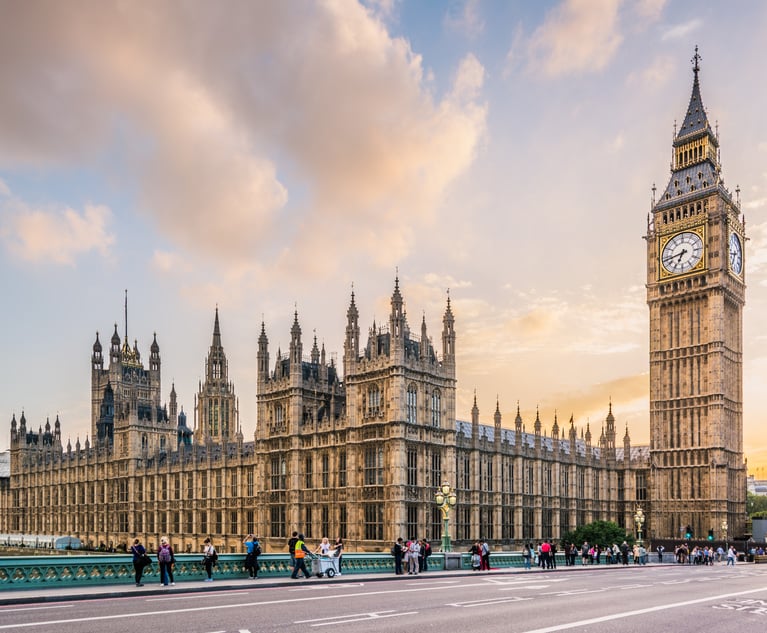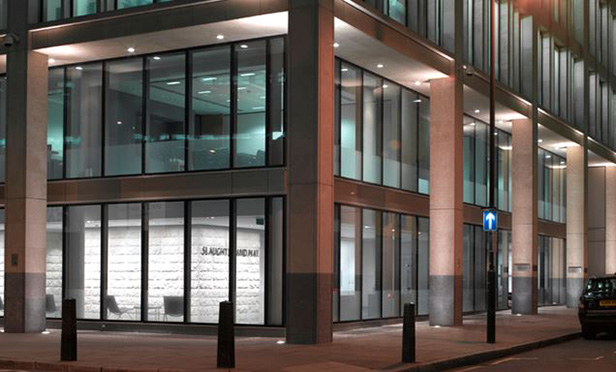Slaughter and May Reveals Partner Gender Pay Gap For First Time
The magic circle outfit has also announced its ethnicity pay gap as it becomes the latest top firm to divulge figures.
March 26, 2019 at 11:09 AM
3 minute read
Slaughter and May has announced its partner gender pay gap and ethnicity pay gap for the first time.
Male partners at the firm are paid on average 8.9 percent more than their female counterparts, based on figures for the 12 months to the end of April, 2018, the firm announced.
When including all employees, the mean and median pay gap at the elite outfit has remained flat at 14.4 percent and 38.7 percent respectively, compared with 14.3 percent (mean) and 38.5 percent (median) last year.
Meanwhile, the firm's mean ethnicity pay gap for employees stands at 9.7 percent and median at 20.4 percent.
When partners are included in the ethnicity figures, that gap jumps to 51.1 percent (mean) and 19.4 percent (median.)
It is the first year the firm has revealed its data for just partners. Last year, the firm released combined figures for partners and employees and did not announce an ethnicity pay gap.
Slaughter and May executive partner Paul Stacey said in a statement: "We are working hard to maintain and enhance an inclusive culture at the firm, including leading from the top, and continue to look at ways to address our gender pay gap, recognising that it will take time for some of these benefits to come through.
"We have also published information on our ethnicity pay gap for the first time. We see this as an important step in opening up conversations about race in the workplace and working towards businesses reflecting society at large."
Freshfields Bruckhaus Deringer, meanwhile, has also reported its gender and ethnicity pay gaps.
The magic circle firm said 4.2 per cent of its partnership identifies as BAME and registered a 33.4 percent mean ethnicity pay gap for its partners. For the whole firm, including partners, the average ethnicity pay gap stands at 58.3 percent and the median average is 12.2 percent.
The firm says in its report that the gap is due to a lack of senior BAME employees.
The firm's mean gender pay gap, which includes those at partner level, is 57.6 percent, down from 60.4 percent in 2017. The median pay gap has also improved to 18.4 percent, down from 34.1 percent.
For partners alone, the mean pay gap has dropped marginally to 18.3 percent and has risen by 3 percent on last year to 20.6 percent. The firm's partnership is 23 percent female.
The pair are the last of the magic circle firms to announce their figures for the most recent financial year. Linklaters reported a 30.3 percent ethnicity pay gap on a mean basis for the whole firm, including equity partners, for 2018. Of the 83 percent of Linklaters staff that disclosed their ethnicity, 21 percent come from a BAME background.
Allen & Overy, meanwhile, has a 14 percent BAME workforce and reported a 21.6 percent pay gap.
Clifford Chance's mean partnership gender pay gap is 25.9 percent – down from 27.3 percent last year – while the median pay gap dropped to 30.5 percent.
CC's mean ethnicity pay gap is 52 percent, with 8.1 percent of its partners identifying as BAME. About 20 per cent of the firm's total employees identify as such. In the U.K., 2.7 percent of the partnership identifies as LGBT. While no partners reported having a disability, 1.6 percent of all firm employees did so.
This content has been archived. It is available through our partners, LexisNexis® and Bloomberg Law.
To view this content, please continue to their sites.
Not a Lexis Subscriber?
Subscribe Now
Not a Bloomberg Law Subscriber?
Subscribe Now
NOT FOR REPRINT
© 2025 ALM Global, LLC, All Rights Reserved. Request academic re-use from www.copyright.com. All other uses, submit a request to [email protected]. For more information visit Asset & Logo Licensing.
You Might Like
View All
Malaysia’s Shearn Delamore Set To Expand Local Footprint With New Office Launch


CMA Uses New Competition Powers to Investigate Google Over Search Advertising

‘A Slave Drivers' Contract’: Evri Legal Director Grilled by MPs
Trending Stories
- 1Snapshot Judgement: The Case Against Illustrated Indictments
- 2Texas Supreme Court Grapples Over Fifth Circuit Question on State Usury Law
- 3Exploring the Opportunities and Risks for Generative AI and Corporate Databases: An Introduction
- 4Farella Elevates First Female Firmwide Managing Partners
- 5Family Court 2024 Roundup: Part I
Who Got The Work
J. Brugh Lower of Gibbons has entered an appearance for industrial equipment supplier Devco Corporation in a pending trademark infringement lawsuit. The suit, accusing the defendant of selling knock-off Graco products, was filed Dec. 18 in New Jersey District Court by Rivkin Radler on behalf of Graco Inc. and Graco Minnesota. The case, assigned to U.S. District Judge Zahid N. Quraishi, is 3:24-cv-11294, Graco Inc. et al v. Devco Corporation.
Who Got The Work
Rebecca Maller-Stein and Kent A. Yalowitz of Arnold & Porter Kaye Scholer have entered their appearances for Hanaco Venture Capital and its executives, Lior Prosor and David Frankel, in a pending securities lawsuit. The action, filed on Dec. 24 in New York Southern District Court by Zell, Aron & Co. on behalf of Goldeneye Advisors, accuses the defendants of negligently and fraudulently managing the plaintiff's $1 million investment. The case, assigned to U.S. District Judge Vernon S. Broderick, is 1:24-cv-09918, Goldeneye Advisors, LLC v. Hanaco Venture Capital, Ltd. et al.
Who Got The Work
Attorneys from A&O Shearman has stepped in as defense counsel for Toronto-Dominion Bank and other defendants in a pending securities class action. The suit, filed Dec. 11 in New York Southern District Court by Bleichmar Fonti & Auld, accuses the defendants of concealing the bank's 'pervasive' deficiencies in regards to its compliance with the Bank Secrecy Act and the quality of its anti-money laundering controls. The case, assigned to U.S. District Judge Arun Subramanian, is 1:24-cv-09445, Gonzalez v. The Toronto-Dominion Bank et al.
Who Got The Work
Crown Castle International, a Pennsylvania company providing shared communications infrastructure, has turned to Luke D. Wolf of Gordon Rees Scully Mansukhani to fend off a pending breach-of-contract lawsuit. The court action, filed Nov. 25 in Michigan Eastern District Court by Hooper Hathaway PC on behalf of The Town Residences LLC, accuses Crown Castle of failing to transfer approximately $30,000 in utility payments from T-Mobile in breach of a roof-top lease and assignment agreement. The case, assigned to U.S. District Judge Susan K. Declercq, is 2:24-cv-13131, The Town Residences LLC v. T-Mobile US, Inc. et al.
Who Got The Work
Wilfred P. Coronato and Daniel M. Schwartz of McCarter & English have stepped in as defense counsel to Electrolux Home Products Inc. in a pending product liability lawsuit. The court action, filed Nov. 26 in New York Eastern District Court by Poulos Lopiccolo PC and Nagel Rice LLP on behalf of David Stern, alleges that the defendant's refrigerators’ drawers and shelving repeatedly break and fall apart within months after purchase. The case, assigned to U.S. District Judge Joan M. Azrack, is 2:24-cv-08204, Stern v. Electrolux Home Products, Inc.
Featured Firms
Law Offices of Gary Martin Hays & Associates, P.C.
(470) 294-1674
Law Offices of Mark E. Salomone
(857) 444-6468
Smith & Hassler
(713) 739-1250









